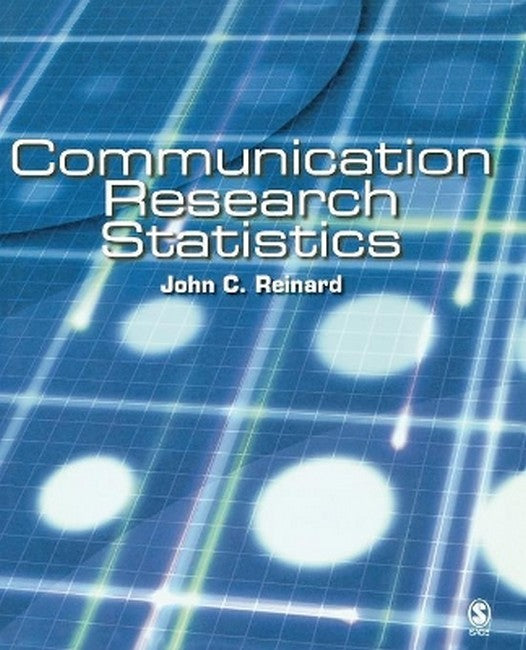John C. Reinard (Ph.D., Southern California) is a professor of Human Communication Studies at California State University, Fullerton. He regularly teaches graduate and undergraduate courses in research methods, quantitative research, persuasion, critical thinking, and argumentation. He received his Ph.D. from the University of Southern California in 1975, after which he served on the faculties at California Polytechnic State University, San Luis Obispo and Arizona State University. He also has served as a master instructor in statistical process control for Motorola. He is the author of Introduction to Research in Communication, soon to be published in its fourth edition, as well as Foundations of Argument. His research has focused primarily in the areas of communication and the law, persuasion, and argumentation. He has published his research in journals including Communication Monographs, the Journal of Communication, Human Communication Research, and Argumentation and Advocacy. He has authored over 100 books, articles, chapters, and research reports presented at professional meetings and conventions. He has served as an Associate Editor for the Journal of Communication, Human Communication Research, Communication Monographs, Argumentation and Advocacy, Communication Quarterly, Communication Reports, Communication Education, and the Western Journal of Communication. He has twice received his University's Author Award and has also been honored with its Outstanding Scholarly and Creative Activity Award. He has chaired five interest groups in professional organizations and has served on committees of three professional organizations. He lives with his wife in Southern California and in his spare time he plays the piano and is a gourmet chef.
Request Academic Copy
Please copy the ISBN for submitting review copy form
Description
Preface Section One: Introduction to Statistical Analyses 1. Using Statistics to Conduct Quantitative Research A World of Statistics Why Do Quantitative Research? Typical Steps Involved in Quantitative Research 2. Collecting Data on Variables Variables and Hypotheses Measurement of Variables Sampling Section Two: Descriptive Statistics 3. Central Tendency Doing a Study and Reporting Descriptive Information Typical Measures of Central Tendency Relations among Mean Median and Mode 4. Looking at Variability and Dispersion Assessing Dispersion The Relationship Between Measures of Central Tendency and Variability Examining Distributions 5. Correlations The Notion of Correlation Elements of the Correlation Computing the Pearson Product-Moment Correlation Matters Affecting Correlations Methods of Correlations Alternative Forms of Association 6. Ensuring Reliability and Validity The Notion of Measurement Acceptability How to Do a study of Measurement Adequacy Reliability Validity The Relation of Validity to Reliability Section Three: Inferential Statistics 7. Statistical Significance Hypothesis Testing when Comparing Two Means Doing a Study that Tests a Hypothesis of Differences Between Means Assumptions in Parametric Hypothesis Testing Comparing Sample and Population Means Comparing the Means of Two Sample Groups: The Two-Sample t Test Comparing Means Differences of Paired Scores: The Paired Difference t Assessing Power 8. Comparing More than Two Means: One-Way Analysis of Variance Hypothesis Testing for More than Two Means The Analysis of Variance Hypothesis Test What after ANOVA? Multiple Comparison Tests Extensions of Analysis of Variance 9. Factorial Analysis of Variance Doing a Study that Involves More than One Independent Variable Types of Effect to Test Computing the Fixed-Effect ANOVA Random and Mixed-Effects Designs Section Four: Nonparametric Tests 10. Nonparametric Tests for Categorical Variables The Notion of "Distribution-Free" Statistics Conducting a Study that Requires Nonparametric Tests of Categorical Data The Chi-Square Test Alternatives to Chi-Square for Frequency Data 11. Nonparametric Tests for Rank Order Dependent Variables Doing a Study Involving Ordinal Dependent Variables Comparing Ranks of One Group to Presumed Populations Characteristics: Analogous Tests to One-Sample t Tests Comparing Ranks from Two Sample Groups Comparing Ranks from More than Two Sample Groups: Analogous Tests to One-Way ANOVA Section Five: Advanced Statistical Applications 12. Meta-Analysis Meta-Analysis: An Alternative to Artistic Literature Reviews Conducting the Meta-Analysis Study Using Computer Techniques to Perform Meta-Analysis 13. Multiple Regression Correlation Contrasting Bivariate Correlation and Multiple Regression Correlation Components of Multiple Correlations How to Do a Multiple Regression Correlation Study 14. Extensions of Multiple Regression Correlation Using Categorical Predictors Contrasting Full and Reduced Models: Hierarchical Analysis Interaction Effects Examining Nonlinear Effects 15. Exploratory Factor Analysis Forms of Factor Analysis The Notion of Multivariate Analyses Exploratory Factor Analysis 16. Confirmatory Factor Analysis Through the AMOS Program The Notion of Confirmatory Factor Analysis Using the AMOS Program for Confirmatory Factor Analysis 17. Modeling Communication Behavior The Goals of Modeling How to Do a Modeling Study Path Models Using the AMOS Program Appendix A: Using Excel XP to Analyze Data Getting Ready to Run Statistics With Excel Handling Data Using the Menu Bar Toolbars How to Run Statistics From the Analysis ToolPak Using Functions Appendix B: Using SPSS 12 for Windows How to enter and Screen Your Own Data in SPSS How to Enter Data From a Word Processor How to Create Indexes From Scales Commands in the SPSS System Dealing With Output Alternative Editing Environments Appendix C: Tables References Index About the Author
"Reinard sets forth a solid intermediate level statistics book that could serve students in advanced researcg classes quite well. In essence, this text would help with the quagmire many students encounter when reading statistics books." -- S.-A. Welch "Each chapter provides a minimum of formulae and avoids complex numerical computations. To some, this approach will appear to be the end of the world as we know it. But, in my experience, detailed examination of statistical formulae via hand computations leads to anxiety about arithmetic rather than a deepening of understanding of statistics for a majority of students. It is only after the anxiety is dealt with, and the student has a degree of facility with statistics, that a deepening understanding can occur with such methods. The book adopts a conceptual rather than a computational approach, and this is to be commended." -- Stephen Cox

